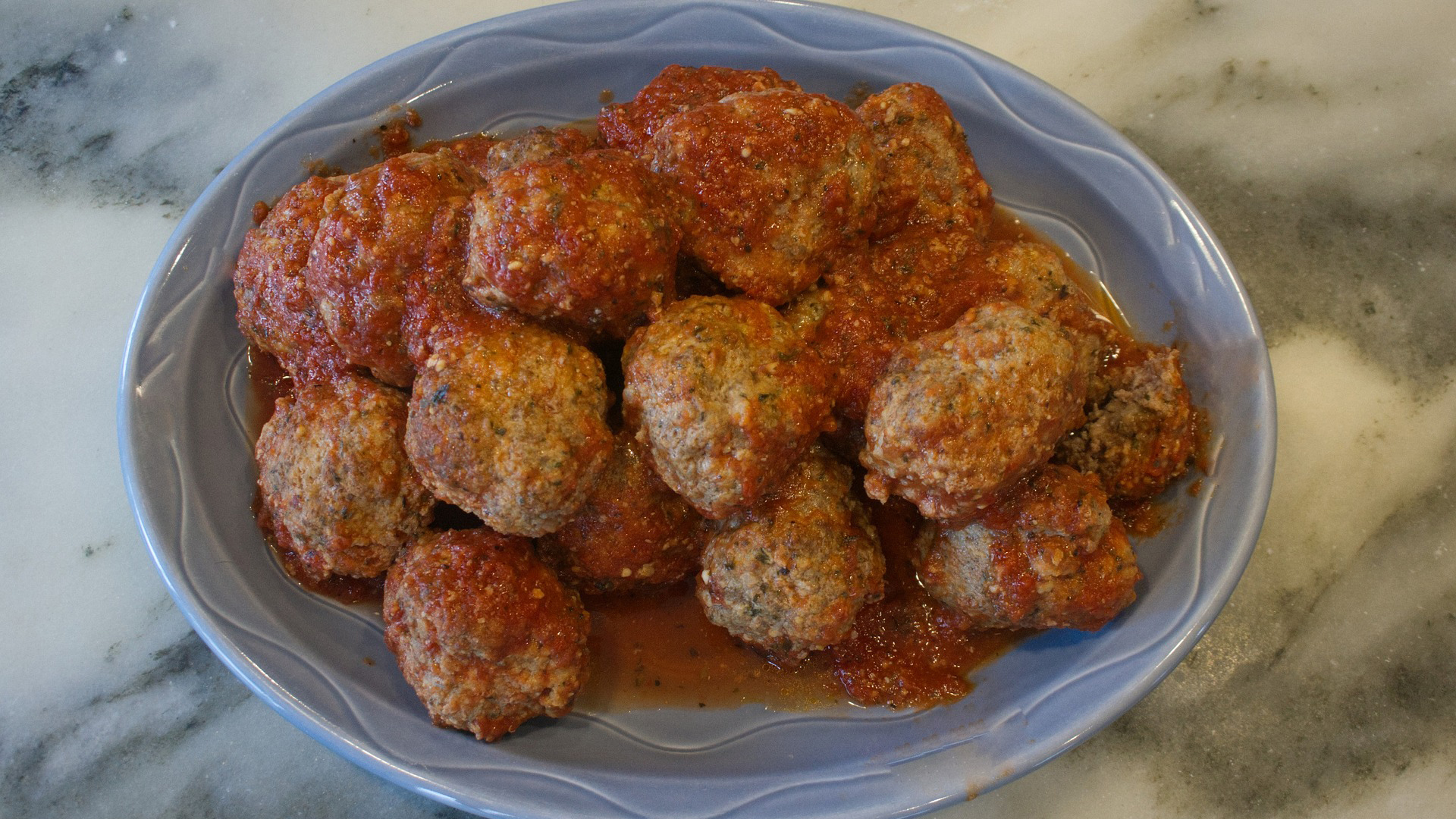Spaghetti and meatballs is a classic Italian American dish, but you'll be hard pressed to find a similar dish in Italy. That's not to say Italians don't love meatballs too, but polpette, as meatballs are known as in Italy, aer quite a bit different than the red sauce dish familiar to Americans.
The Ancient Meatball
The cuisines of the Mediterranean basin are filled with meatballs such as Greek Keftedes, Turkish Kofta, and Spanish Albondigas. All of these dishes likely trace their origins to ancient Persia, where the term kofte means pounded meat. The recipe arrived in the Mediterranean by way of the Silk Road, a trading route linking Europe and Asia.
By the first century B.C.E, ancient Romans were eating cooked balls made of meat and fish. Early meatball recipes are credited to Marco Gavio Apicio, an early gourmande whose study of gastronomy is the basis for De re coquinaria, an early European cookbook. The actual manuscript dates some four to five hundred years after Apicio lived, but much of it is thought to have been based on his writings.

Italian Meatballs
Although meatballs have existed since ancient Rome, the word Polpetta doesn't appear until the 15th Century. Martino de' Rossi uses the phrase in his Libro de Arte Coquinaria, one of the best-known works on Medieval cooking.
The word Polpette is likely derived from polpa, translated as lean meat or flesh. But, this is something of a misnomer, since polpette can be made from meat, fish, vegetables, and in some cases, cheese. While American meatballs are made with raw ground meat, that isn't necessarily true of polpette where the meat might be boiled or braised before being shaped into a ball. Larger variations known as polpettone are comparable to meatloaf.
Around the time of the Italian diaspora, meatballs were a well-known use for extra meat, as documented in Pellegrino Artusi's 1891 recipe collection, Science in the Kitchen and the Art of Eating Well. He jokes in the recipe collection that even a donkey could prepare a meatball, meaning everyone knows how to make them. However, his recipe includes flavorings like raisins and pine nuts, and the serving suggestion is to garnish the meatball with an egg, a somewhat different presentation than the Italian American standard.
Meatballs in Italy appear in unlikely places. While Italians may not serve them over spaghetti, they can be found in Neapolitan lasagna di Carnevale. Tiny meatballs also are commonly served in soup, like those found floating in Italian Wedding Soup.
It isn't entirely true that spaghetti and meatballs are impossible to find in Italy. According to Katie Parla in her new cookbook, Food of the Italian Islands, in the town of Loreto Aprutino in the region of Abruzzo, a local dish includes vermicelli-style pasta with tiny meatballs and tomato sauce. The dish is virtually unknown outside of the small village. Another example Parla mentions is served at the restaurant Il Rifugio in Nuoro, on the Island of Sardinia, where the meatballs top disc-shaped pasta.

Italian Americans Invent a Classic
The immigrants arriving in the United States at the end of the 19th century were poor, and meatballs are an ideal way of extending expensive products like meat with cheaper products like breadcrumbs, made from stale bread.
These meatballs often ended up in tomato sauce alongside sausages, veal shanks, and other affordable meats. The sauces, based on Neapolitan ragú, were often cooked on Sunday when extended families gathered. Adding meat to the sauce was still then a luxury, and is the origin of the term "Sunday sauce," used to differentiate it from meatless sauce served during the week. In some communities, the Sunday Sauce is known as gravy.
In the first decades of the twentieth century, spaghetti was increasingly becoming a popular dish not just in Italian households, but in Italian American restaurants catering to a rising bourgeois class. Non-Italians looking for adventure, and a cheap meal, would seek out Italian cuisine.
Macaroni – that is, dried pasta – was also becoming a big business. By the 1920s, a trade organization for macaroni manufacturers had launched a magazine, The New Macaroni Journal. The magazine published financial information, important pasta news, advertising for innovations like boxed pasta, and recipes. However, some of the stories the magazine published were less than accurate, such as the fictional story about Marco Polo discovering pasta in China.
A 1922 issue of the magazine featured the favorite recipes of Italian movie star Rudy Valentino. Valentino was a silent movie star and Italian sex symbol known as the Latin lover. The magazine published the recipes side by side, one for spaghetti with tomato sauce and another recipe for meatballs. By coincidence, the American Beauty Macaroni Company began advertising spaghetti, including a picture of spaghetti topped meatballs. A legendary recipe was born.
Spaghetti and meatballs proved to be a popular dish, and more importantly by the 1930s, an economically sound one. With the onset of the Great Depression, low cost macaroni became a staple meal for many Americans, not just those of Italian descent. Meatballs offered an inexpensive way to add meat to the dish. To further cut costs, "porcupine meatballs" were made with rice, named because the rice appeared like porcupine quills.

Meatballs Become an American Icon
World War II changed a great many things about American society, especially the way Americans ate. Some 16 million men were sent to war, and along the way, they experienced a variety of new foods in Europe and the Pacific. However, the food they brought with them was also new and different.
For instance, the military's field cookbook used by the army chefs included a recipe for meatballs and tomato sauce. Technically, the recipe was not exclusively for spaghetti and meatballs. The versatile cookbook included a recipe for meatballs and suggested numerous ways of serving them, including tomato sauce. Even suggesting an Italian-style meatball was a big step for a country that worried Joe DiMaggio might reek of garlic (he never did, declared a 1939 issue of Life Magazine).
The U.S. Army also brought with it canned pastas from Chef Boyardee. The Boyardee factory churned out army rations 24 hours a day, ensuring a generation of servicemen would develop a taste for the canned pasta when they returned.
The Modern Meatball
For the last five years, New York City's San Gennaro festival has featured a meatball eating contest. Over the course of eight to ten minutes, contestants chow down on as many meatballs as possible. Winners have eaten as many as 47 meatballs in the past. Even as Italian American restaurants shift away from red sauce favorites of the last century to Italian cuisine more reminiscent of foods eaten in Italy, spaghetti and meatballs remain a favorite on many menus.
Ian MacAllen
Ian MacAllen is America Domani's Senior Correspondent and the author of Red Sauce: How Italian Food Became American. He is a writer, editor, and graphic designer living in Brooklyn. Connect with him at IanMacAllen.com or on Twitter @IanMacAllen.

